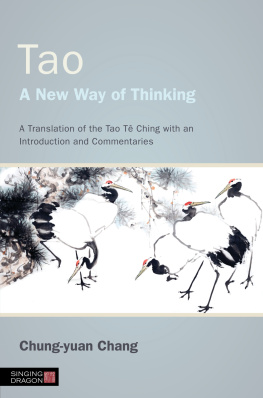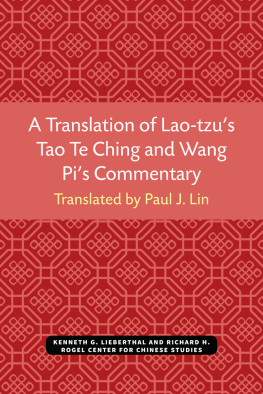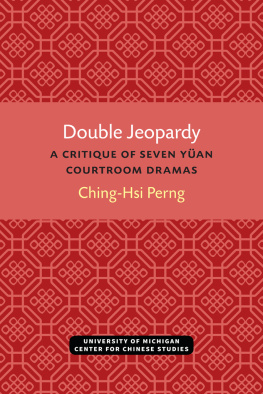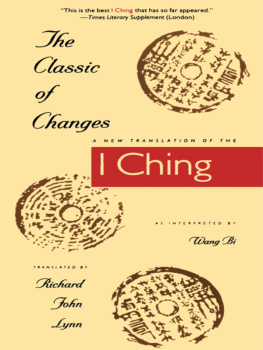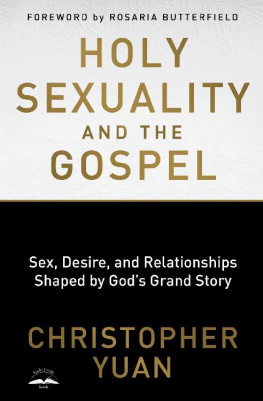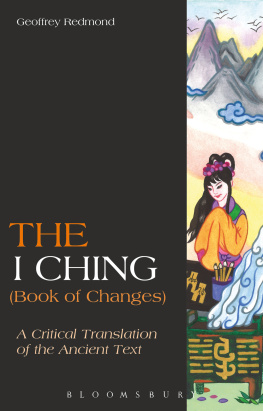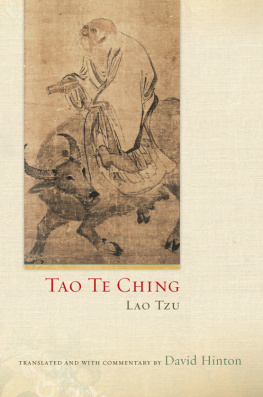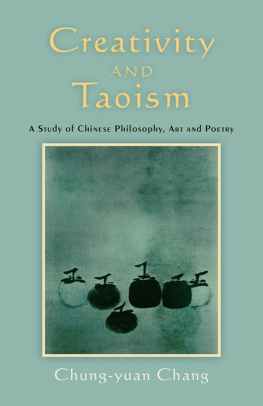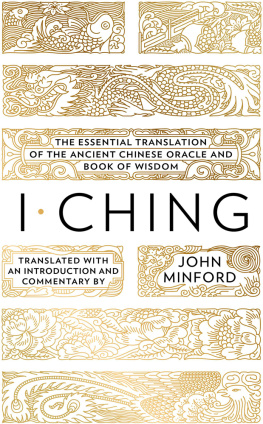Chung-Yuan Chang - Tao - a New Way of Thinking: A Translation of the Tao Te Ching With an Introduction and Commentaries
Here you can read online Chung-Yuan Chang - Tao - a New Way of Thinking: A Translation of the Tao Te Ching With an Introduction and Commentaries full text of the book (entire story) in english for free. Download pdf and epub, get meaning, cover and reviews about this ebook. year: 2013, publisher: Singing Dragon, genre: Science. Description of the work, (preface) as well as reviews are available. Best literature library LitArk.com created for fans of good reading and offers a wide selection of genres:
Romance novel
Science fiction
Adventure
Detective
Science
History
Home and family
Prose
Art
Politics
Computer
Non-fiction
Religion
Business
Children
Humor
Choose a favorite category and find really read worthwhile books. Enjoy immersion in the world of imagination, feel the emotions of the characters or learn something new for yourself, make an fascinating discovery.
- Book:Tao - a New Way of Thinking: A Translation of the Tao Te Ching With an Introduction and Commentaries
- Author:
- Publisher:Singing Dragon
- Genre:
- Year:2013
- Rating:5 / 5
- Favourites:Add to favourites
- Your mark:
- 100
- 1
- 2
- 3
- 4
- 5
Tao - a New Way of Thinking: A Translation of the Tao Te Ching With an Introduction and Commentaries: summary, description and annotation
We offer to read an annotation, description, summary or preface (depends on what the author of the book "Tao - a New Way of Thinking: A Translation of the Tao Te Ching With an Introduction and Commentaries" wrote himself). If you haven't found the necessary information about the book — write in the comments, we will try to find it.
Chung-Yuan Chang: author's other books
Who wrote Tao - a New Way of Thinking: A Translation of the Tao Te Ching With an Introduction and Commentaries? Find out the surname, the name of the author of the book and a list of all author's works by series.
Tao - a New Way of Thinking: A Translation of the Tao Te Ching With an Introduction and Commentaries — read online for free the complete book (whole text) full work
Below is the text of the book, divided by pages. System saving the place of the last page read, allows you to conveniently read the book "Tao - a New Way of Thinking: A Translation of the Tao Te Ching With an Introduction and Commentaries" online for free, without having to search again every time where you left off. Put a bookmark, and you can go to the page where you finished reading at any time.
Font size:
Interval:
Bookmark:
CONTENTS
Tao
A New Way of Thinking
Chapter 40
Reverse is the movement of Tao .
Yielding is the action of Tao .
Ten thousand things in the universe are created from being.
Being is created from non-being.
Commentary
In his Annotations and Explanations of the Lao Tzu , Chiang Hsi-chang explains the meaning of fan , or reversal:
From action and many words, reverse to non-action and speechlessness; from knowledge and intention, reverse to no knowledge and no intention. All this refers to the meaning of fan , or reversal.
Fan , or reversal, is the most fundamental approach to Tao. As Lao Tzu says:
To learn, one accumulates day by day.
To study Tao , one reduces day by day.
In Heideggers terms, the reduction of thought is the reversal from calculative thinking to meditative thinking. In On the Way to Language he quotes a poem by Stefan George which ends: Where word breaks off no thing may be.
The editor of Heideggers most recent work, On Time and Being , states: After Time and Being , Heidegger abandons the distinction between metaphysics as traditional philosophy and fundamental ontology, the ontology of being for which he was seeking.
For Heidegger, the step back is the return to the origin of thinking which is prior to thought. He asks: What is this origin? For Lao Tzu, the origin is wu , or non-being. In his words:
All things in the universe are created from yu , or being,
Being is created from wu , or non-being.
In Existence and Being , Heidegger asks: Why is there any being at allwhy not far rather nothing? He says that one must let ones self go into nothing and not establish being as the ground. Nothing is the source; being is its manifestation. Lao Tzus thought may be closely related to Heideggers essential change of thinking. Thus, this chapter may be important to Heideggers recent philosophy.
Notes to Chapter 40
Chiang Hsi-chang, Annotations and Explanations of the Lao Tzu , p. 265.
Heidegger, On the Way to Language , p. 108.
Ibid .
Joan Stambaugh, Introduction, in Heidegger, On Time and Being , p. viii.
Ibid ., p. ix.
Heidegger, Identity and Difference , p. 72.
Ibid .
Martin Heidegger, An Introduction to Metaphysics , trans. by Ralph Manheim (New York: Doubleday and Company, Inc., 1959), p. 172.
Heidegger, Existence and Being , p. 349.
Chapter 41
When a man of superior talent listens to Tao , he earnestly applies it.
When an ordinary man listens to Tao , he seems to believe it and yet not to believe it.
When the worst man listens to Tao , he greatly ridicules it.
If he did not ridicule it, it would not be Tao .
Therefore, in Chien-yen we have:
Understand Tao as if you do not understand it;
Enter into Tao as if you are coming out of it;
Move smoothly with Tao as if you are having difficulties.
The highest attainment is as if it is no attainment.
All-embracing attainment is as if it is lacking attainment.
Rigorous attainment is as if it is indolent loafing.
Real essence is as if it is empty.
The great white is as if it is black.
The great square is without corners.
Great capacity is successful in its later days.
Great music is without sound.
The great image is without form.
Tao is concealed and without name.
Nevertheless, Tao furnishes all things and fulfills them.
Commentary
This chapter further illustrates the movement of reversal discussed in Chapter 40. It was mentioned that in Heideggers thought, the movement of reversal is the step back out of the realm of metaphysics into its essential origin. This origin is Saying, the way-making movement of the worlds fourfold. It is the movement at the core of the worlds four regions, which makes them reach one another and holds them in the nearness of their distance. Holding the worlds four regions in the nearness of their distance indicates the movement of reversal as it relates to the origin of Saying, or Tao.
According to Lao Tzu: Tao is concealed and without name Nevertheless, Tao furnishes all things and fulfills them. In Heideggers thought, saying is what remains unsaid, what is not yet shownabides in concealment as unshowable, is mystery.
Further, Lao Tzu says: Great white is as if it is black; the great image is without form; great music is without sound. This is all attributed to Tao. In Heideggers essay Poetically Man Dwells, we read: The poetic saying of images gathers the brightness and sound of the heavenly appearances into one with the darkness and silence of what is alien. Thus, as Lao Tzu says: Understand Tao as if you do not understand it. Further, the highest attainment is as if it is no attainment.
According to the critic Yen Y of the twelfth century, when Tao , or Saying, is applied to Chinese poetry, it makes the poetry resemble the antelope hanging by its horns on the tree, leaving no traces to be found. Thus, this chapter paves the way for the highest attainment of Chinese art and poetry.
Notes to Chapter 41
According to Chi Tung and Kao Heng, Chien-yen is the title of the ancient book. Some commentators believe that the term chien-yen means an established saying that is transmitted orally.
Kao Heng maintains that the highest attainment should be followed immediately by all-embracing attainment and rigorous attainment.
Kao Heng also maintains that great whiteness should be followed immediately by the great square, great capacity, great music, and the great image.
Heidegger, On the Way to Language , p. 104.
Ibid. , p. 122.
Heidegger, Poetry, Language, Thought , p. 226.
Heidegger, On the Way to Language , p. 104.
Yen Y, Critique of Poetry , annotated with commentary by Kuo Shao-y (Peking: Peoples Literature Press, 1962), p. 24.
Chapter 42
From the Tao , one is created;
From one, two;
From two, three;
From three, ten thousand things.
All of them achieve harmony through the unification of affirmation and negation
Which is embraced by everything.
No one likes to be isolated (ku) , without merit (kua) , or worthless (pu ku) ,
Yet rulers refer to themselves with these names.
Thus, some things add to their value by reducing their value.
Some things reduce their value by adding to their value.
Other ancients have taught this;
I teach it too.
The man of violence will end his life in violence.
This is a basic motto.
Commentary
This chapter indicates two basic principles of creativity maintained by Nishida. One is living by dying. The other is the determination of the individual by the universal of universals. As Nishida says, that which exists in the universal of universals lives by dying, i.e., it is the continuity of discontinuity.
With respect to the determination of the individual by the universal of universals, Nishida says: The concrete universal includes the universal which determines the individual, i.e., it is the universal of universals. This is the meaning of my idea of the determination of the universal of nothingness That which exists in such a universal is determined from the infinite past in the sense of being determined by the universal of universals. This universal of universals, or the universal of nothingness, is the Tao in Lao Tzus thought. From the Tao , one is created, then two, then ten thousand individuals.
Chuang Tzu further develops Lao Tzus process of creativity. As he says in Chapter 12 of his works:
In the great beginning there was non-being which was nothing and nameless. It was whence the one emerged. The one was inherent in it, but was not yet formed. Through it, things were created which were called its achievements. That is, through the formless, differentiations were produced. This process of differentiation proceeds unceasingly, and is called life. When the movement of life pauses, things are produced. When things are produced, different characteristics are created. This is the form of things. In the form of things there is a spiritual reality which is manifested into different particularities. This is called the nature of things. To cultivate this nature is to reverse the attainment. This reversal of attainment identifies with the great beginning. This identity with the great beginning is non-being which is the all-embracing.
Next pageFont size:
Interval:
Bookmark:
Similar books «Tao - a New Way of Thinking: A Translation of the Tao Te Ching With an Introduction and Commentaries»
Look at similar books to Tao - a New Way of Thinking: A Translation of the Tao Te Ching With an Introduction and Commentaries. We have selected literature similar in name and meaning in the hope of providing readers with more options to find new, interesting, not yet read works.
Discussion, reviews of the book Tao - a New Way of Thinking: A Translation of the Tao Te Ching With an Introduction and Commentaries and just readers' own opinions. Leave your comments, write what you think about the work, its meaning or the main characters. Specify what exactly you liked and what you didn't like, and why you think so.

